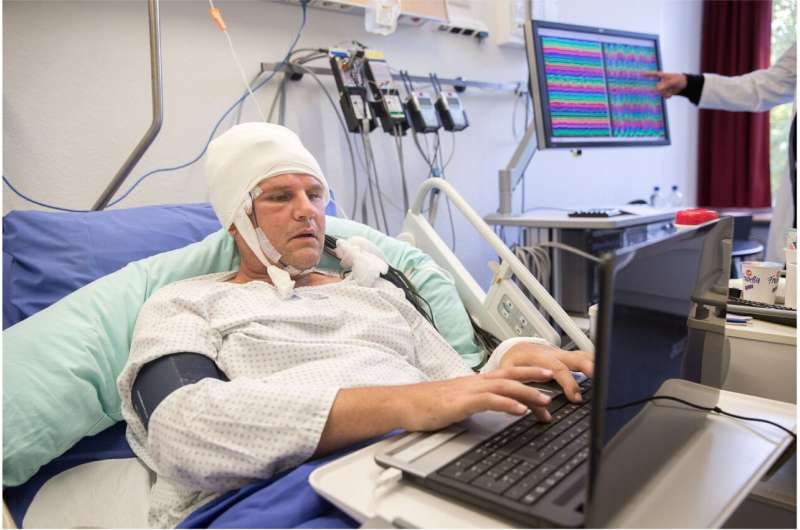July 20, 2023 feature
This article has been reviewed according to Science X's editorial process and policies. Editors have highlighted the following attributes while ensuring the content's credibility:
fact-checked
peer-reviewed publication
trusted source
proofread
Study shows how the brain coordinates neuronal processing and communication during sleep

Past neuroscience studies have shown that while humans are sleeping, the brain remains highly active, consolidating memories and removing toxins accumulated during waking hours. While memory consolidation during sleep is a widely documented phenomenon, the processes underpinning it are yet to be fully elucidated.
Researchers at University of Oxford, the Hebrew University of Jerusalem and University of Bonn Medical Center recently carried out a study investigating the neural mechanisms through which the brain facilitates neuronal processing and communication between neurons during sleep. Their paper, published in Nature Neuroscience, unveils the processes through which the sequential unfolding of specific sleep rhythms coordinates memory consolidation while humans are asleep.
"We know that our brains work actively on strengthening memories while we sleep, but how exactly this is accomplished is still poorly understood," Bernhard Staresina, one of the researchers who carried out the study, told Medical Xpress.
"A few years ago, we found that some of the key sleep signatures ('slow oscillations,' 'spindles' and 'ripples') coincide in the hippocampus, the brain's 'memory hub.' This was a good indication that the synchronization of these sleep rhythms may be involved in memory consolidation. What was missing, however, was evidence that they in fact impact neuronal firing rates, i.e., the 'hard currency' of learning and plasticity."

To explore the neural underpinnings of neuronal processing and communication during sleep, Staresina and his colleagues recorded the brain activity of 10 human participants as they were asleep using a technique known as intracranial electroencephalography (iEEG). These participants were patients with epilepsy who had electrodes implanted in their brain as part of their treatment.
While the patients were sleeping, Staresina and his colleagues simultaneously recorded their sleep rhythms and neuron firing rates. The recordings they collected showed that firing rates and neural communication are indeed orchestrated by slow oscillations, spindles and ripples, as they hypothesized.
"We recorded brain activity in the medial temporal lobe of epilepsy, a region known to be important for memory," Staresina explained. "Recordings took place during natural sleep, without any experimental manipulations. The key innovation is that we used special electrodes for our recordings. These electrodes not only record the (standard) brain signatures (intracranial Electroencephalogram, iEEG), but special 'microwires' allow detection of action potentials of individual neurons and groups of neurons."

While several previous studies have recorded neuronal activity during sleep, most of them relied on non-invasive imaging techniques, which are easier to use, yet they do not provide as much insight into what is happening in the brain. Staresina and his colleagues were able to record more precise measurements, leveraging depth electrodes that were implanted in the brain of patients with treatment-resistant epilepsy as part of their clinical treatment. This ultimately allowed the team to determine how endogenous sleep rhythms regulate neuronal activity.
"It is remarkable to see how the brain, seemingly left to its own devices, carefully regulates neuronal firing and communication, presumably in service of memory formation," Staresina said. "It uses its internal machinery of brain rhythms to increase firing rates to a point where new synapses can be forged. Experimentally supporting the brain to bring these brain rhythms in alignment (e.g., by targeted invasive or non-invasive stimulation) holds great promise for combating memory loss seen in healthy aging or in neurodegenerative diseases."
The recent study by this research team shed some new light on one of the most fascinating mysteries of the brain: how it consolidates memories during sleep. In the future, it could pave the way for more research examining the processes it uncovered, potentially leading to exciting new discoveries.
"We still need to confirm the types of memory that benefit from coupled sleep rhythms," Staresina added. "Is it particularly associative memories (e.g., remembering the name of a recent encounter), which we know to rely on the hippocampus? Or is it all sorts of memory and even cognitive functions beyond memory (e.g., attention, emotion regulation)? In parallel, we are now exploring non-invasive means to bolster memory formation during sleep, giving the brain's endogenous sleep rhythms a gentle nudge at the right moments."
More information: Bernhard P. Staresina et al, How coupled slow oscillations, spindles and ripples coordinate neuronal processing and communication during human sleep, Nature Neuroscience (2023). DOI: 10.1038/s41593-023-01381-w
© 2023 Science X Network




















